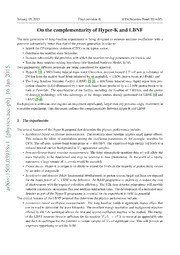Table Of ContentJanuary 19,2015 Final(revision4) ICFANeutrinoPanel2014(02)
On the complementarity of Hyper-K and LBNF
The next generation of long-baseline experiments is being designed to measure neutrino oscillations with a
precision substantially betterthanthatofthepresentgeneration inorderto:
• SearchforCP-invariance violation (CPiV)intheleptonsector;
• Determinetheneutrino masshierarchy;
• Increasesubstantially theprecision withwhichtheneutrino-mixing parameters areknown;and
• Testthethree-neutrino-mixing hypothesis (theStandardNeutrinoModel,SνM).
5 Twoqualitatively different proposals arebeingconsidered forapproval:
1 ◦
• Hyper-K [1],a560kTonnefiducialmasswaterCherenkov detector located 2.5 off-axis atadistance of
0
2 295kmfromthenarrow-band beamproduced byanupgraded, ∼ 1MW,protonbeamatJ-PARC;and
n • The Long Baseline Neutrino Facility (LBNF) [2, 3], a 40kTonne fiducial mass liquid-argon time pro-
a
J jection chamber (LAr)illuminated byanewwide-band beamproduced bya1.2MWproton beam tobe
6 built at Fermilab. The specification of the facility, including the baseline of 1300km, and the choice
1
of detector technology will take advantage of the design studies already performed for LBNE [4] and
] LBNO[5–8].
h
p Eachprojectisambitiousandrequiresaninvestmentsignificantlylargerthananyprevioussingleinvestmentin
-
aneutrinoexperiment. Thisdocumentoutlines thecomplimentarity betweenHyper-KandLBNF.
c
c
a
.
s
1 The experiments
c
i
s
y
ThecriticalfeaturesoftheHyper-Kproposal thatdetermine thephysicsperformance include:
h
p • Accelerator-based oscillation measurements: The relatively short baseline implies small matter effects.
[
This reduces the effect of correlations among the oscillation parameters in, for example, searches for
1 CPiV.The off-axis, narrow-band beam peaks at ∼ 600MeV. Thesuppressed high-energy tail leads to a
v
8 reducedneutral-current background in֒ν֓e-appearance samples.
1
• Non-accelerator-based neutrino measurements: The large atmospheric-neutrino data set will allow the
9
3 mass hierarchy to be determined and may be sensitive to new phenomena. In the event of a nearby
0 supernova, alargesampleofν¯ eventswouldberecorded.
. e
1
• Protondecay: Hyper-Kisuniqueinitsabilitytoextendthelimitsonthemajorityofprotondecaymodes
0
5 byanorderofmagnitude.
1
• AcceleratoranddetectorR&D:Incrementaldevelopmentstoprotonsource,targetandhornarerequired
:
v for the beam power of ∼ 1MW to be delivered. An R&D programme is underway to reduce the cost
i
X
ofphotosensors with the required collection efficiency. TheT2K near detector programme willprovide
r
a valuableconstraintsonneutrinofluxandneutrino-interaction rates. Thedevelopmentofadedicatednear
detectoraspartoftheHyper-Kprogrammeisessential fortheexperimenttofulfilitspotential.
ThecriticalfeaturesoftheLBNFproposalthatdetermine thephysicsperformance include:
• Accelerator-based oscillation measurements: The long baseline yields a significant matter effect that
can be used to determine the masshierarchy. The excellent energy resolution and background rejection
offered by the LAr technique allows the first and second oscillation maxima to be studied. The energy
of the LBNFneutrino beam is sufficient for the reaction ֒ν֓ N → τ±X to occur at an appreciable rate
τ
andtheLArtechniquehasthepotentialtoisolatesamplesof֒ν֓ ofsignificantsize. Thiswillprovidean
τ
importantopportunity totesttheSνM.
• Non-accelerator-based neutrino measurements: LBNF would accumulate a large “high-resolution” at-
mosphericneutrinosample. TheLArdetectorissensitivetotheν (ratherthantheν¯ )componentofthe
e e
supernovaflux,whichcontainsinformationregardingthe“neutronization burst”(p+e− → n+ν )that
e
isexpected totakeplaceintheearlystagesoftheexplosion.
• Proton decay: The LAr detector, which will be substantially larger than any of those built to date, will
offertheopportunity tosearchforproton-decay modesthatare“preferred” bysupersymmetric models.
• Accelerator and detector R&D: The total fiducial mass of the LAr detector will be implemented using
amodular approach. AnR&Dprogramme to develop the necessary techniques isunderway. The exist-
ingLAr-based program thatincludes ArgoNeuT,MicroBooNE,theLBNE35Tonprototype, CAPTAIN
and LArIAT and the R&D projects developed at the CERN Neutrino Platform, will provide important
information on neutrino-argon interactions, detector response, and reconstruction algorithms. A highly
segmented near detector is essential for the facility to fulfil its potential and is under development. The
proton-beam powerof1.2MWwillbedelivered bytheProtonImprovement PlanIIupgrade totheFer-
−
milab accelerator complex. This requires a 800MeV, superconducting H linac and a new high-power
pion-production target.
2 The qualitativecaseforboth experiments
The accelerator based programmes of both LBNF and Hyper-K have been optimised at the same L/E but
the baselines, L, and energies, E, differ by almost a factor of 5. In each experiment, the large atmospheric-
neutrino sample willextend substantially therange ofLandE thatcanbestudied. Thetwoexperiments have
similar sensitivities to CPiV and will be able to measure the mixing angles with comparable precision. The
longer baseline allowsLBNFtodetermine themasshierarchy. Ifthetwoexperiments progress ontechnically-
limited schedules they will compete to discover CPiV. Given the challenging nature of the measurement and
theimportanceofthediscovery,independentconfirmationbyaqualitativelydifferentexperimentislikelytobe
essential.
The differing degree to which the matter effect modifies the oscillation probabilities at Hyper-K and LBNF
may be exploited to break parameter degeneracies. The different detector technologies and beam energies
implythatneutrinoscatteringinthetwoexperimentsisdominatedbydifferentinteractionprocessesandhence
different eventtopologies. Inaddition, thedetailsofthehadronic processes bywhichthetwonenutrino beams
aregenerated aredifferent. Therefore,thesystematics arequitedifferent atHyper-KandLBNF.
Foragivenparameterset,theSνMspecifiesthattheoscillationprobabilities arefunctionsofL/E. Searches
for non-standard phenomena can therefore be made by exploiting the fact that Hyper-K and LBNF have the
same L/E but different L and E. To put the SνM to the test requires precise measurements of several ob-
servables, including ֒ν֓ (and, if possible, ֒ν֓ ) appearance from a ֒ν֓ beam at different values of L and E,
e τ µ
comparing neutrino datawithantineutrino dataandcomparing accelerator-based measurements withmeasure-
mentsofν¯ disappearance atreactors.
e
Hyper-Kofferstheopportunitytoextendthesensitivitytoprotondecaysignificantlyinseveralmodes,while
theLArdetector atLBNFwillprobenew decaychannels that arenotaccessible towaterCherenkov detectors
andwillprovidenearlybackground-free searchesforotherimportantchannels. Tounderstand themechanisms
ofsupernovaexplosionrequiresaccuratemeasurementsoftheν andν¯ fluxes,alongwithsomeneutralcurrent
e e
data (which is sensitive to the flux of ֒ν֓ ). These measurements can not be made with Hyper-K or LBNF
µ,τ
alone.
2
3 The need to quantify added value
Detailedsimulations arerequired inordertoquantifythecomplimentarity betweenHyper-KandLBNF.Some
representative questions thatneedquantitative studies are:
• SearchingforCP-invariance violation: thedegreetowhichthecombineddatasetenhancesthesensitiv-
ityofsearches forCP-invariance violation;
• Liftingdegeneracies: thedegreetowhichthecombineddatasetreducesthenumberofviableregionsof
multi-parameter space;
• Improved precision: thedegreetowhichfitstothecombined dataset,whichassumesthevalidity ofthe
SνM,willimprovetheprecision oftheparameterdetermination; and
• Testing the SνM framework: the degree to which the combined data set enhances the coverage of the
non-standard-neutrino-model parameterspace.
The benefit that will accrue from the parallel implementation of these complementary experiments should be
quantified atanearlystage.
References
[1] K.Abe,T.Abe,H.Aihara,Y.Fukuda,Y.Hayato,etal.,“LetterofIntent: TheHyper-Kamiokande
Experiment—DetectorDesignandPhysicsPotential—,”arXiv:1109.3262 [hep-ex].
[2] TheLBNFinterimInternational ExecutiveBoard,“Interim International ExecutiveBoard.”
https://web.fnal.gov/project/iiEB/Pages/iiEB-home.aspx,2014.
[3] TheLongBaselineNeutrinoFacillity,“TheLongBaselineNeutrinoFacillity.”
https://web.fnal.gov/project/LBNF/SitePages/Home.aspx,2014.
[4] LBNECollaboration Collaboration, C.Adamsetal.,“TheLong-Baseline NeutrinoExperiment:
Exploring FundamentalSymmetriesoftheUniverse,”arXiv:1307.7335 [hep-ex].
[5] “LAGUNA/LAGUNA-LBNO–Designofapan-European infrastructure forLargeApparatus forGrand
Unification, NeutrinoAstrophysics, andLongBaselineNeutrinoOscillations .”
http://project-lagunalbno.web.cern.ch/project-lagunalbno/.
[6] LAGUNA-LBNOCollaboration Collaboration, S.Agarwallaetal.,“TheLBNOlong-baseline
oscillation sensitivities withtwoconventional neutrinobeamsatdifferentbaselines,”
arXiv:1412.0804 [hep-ph].
[7] LAGUNA-LBNOCollaboration Collaboration, S.Agarwallaetal.,“Optimisedsensitivity toleptonic
CPviolation fromspectralinformation: theLBNOcaseat2300kmbaseline,”
arXiv:1412.0593 [hep-ph].
[8] LAGUNA-LBNOCollaboration Collaboration, S.Agarwallaetal.,“Themass-hierarchy and
CP-violation discoveryreachoftheLBNOlong-baseline neutrino experiment,”JHEP1405(2014)094,
arXiv:1312.6520 [hep-ph].
[9] TheInternational CommitteeonFutureAccelerators, “ICFANeutrinoPanel.”
http://www.fnal.gov/directorate/icfa/neutrino_panel.html,2013.
[10] TheInternational CommitteeonFutureAccelerators, “ICFANeutrinoPanel: termsofreference.”
http://www.fnal.gov/directorate/icfa/files/Terms-Of-Reference.pdf,2013.
3
[11] TheICFANeutrinoPanel,“ICFANeutrinoPanel.”http://www.fnal.gov/directorate/icfa/.
4
A The ICFANeutrino Panel
ICFAestablished theNeutrinoPanelwiththemandate[9]:
Topromoteinternationalcooperationinthedevelopmentoftheaccelerator-basedneutrino-oscillation
programandtopromoteinternationalcollaborationinthedevelopmentaneutrinofactoryasafu-
tureintensesourceofneutrinos forparticle physicsexperiments.
The membership of the Panel agreed by ICFA at its meeting in February 2013 is shown in table 1. The terms
ofreference forthepanel[10]maybefoundonthePanel’sWWWsite[11].
Table1: MembershipoftheICFANeutrinoPanel.
Name Institution
J.Cao IHEP/Beijing
A.deGouveˆa NorthwesternUniversity
D.Duchesneau CNRS/IN2P3
R.Funchal UniversityofSaoPaulo
S.Geer FermiNationalLaboratory
S.B.Kim SeoulNationalUniversity
T.Kobayashi KEK
K.Long(chair) ImperialCollegeLondonandSTFC
M.Maltoni UniversidadAutomataMadrid
M.Mezzetto UniversityofPadova
N.Mondal TataInstitute forFundamental Resarch
M.Shiozawa TokyoUniversity
J.Sobczyk WroclawUniversity
H.A.Tanaka UniversityofBritishColumbiaandIPP
M.Wascko ImperialCollegeLondon
G.Zeller FermiNationalAcceleratorLaboratory
5

